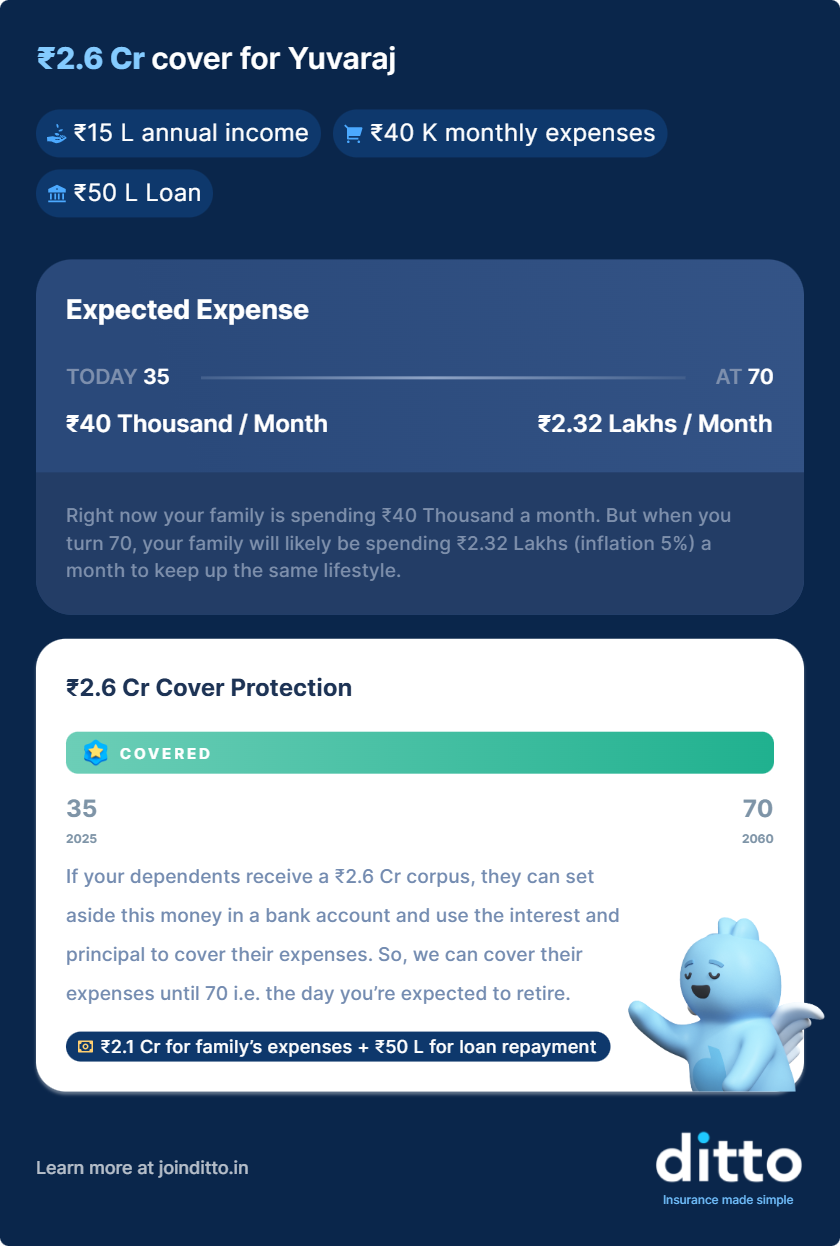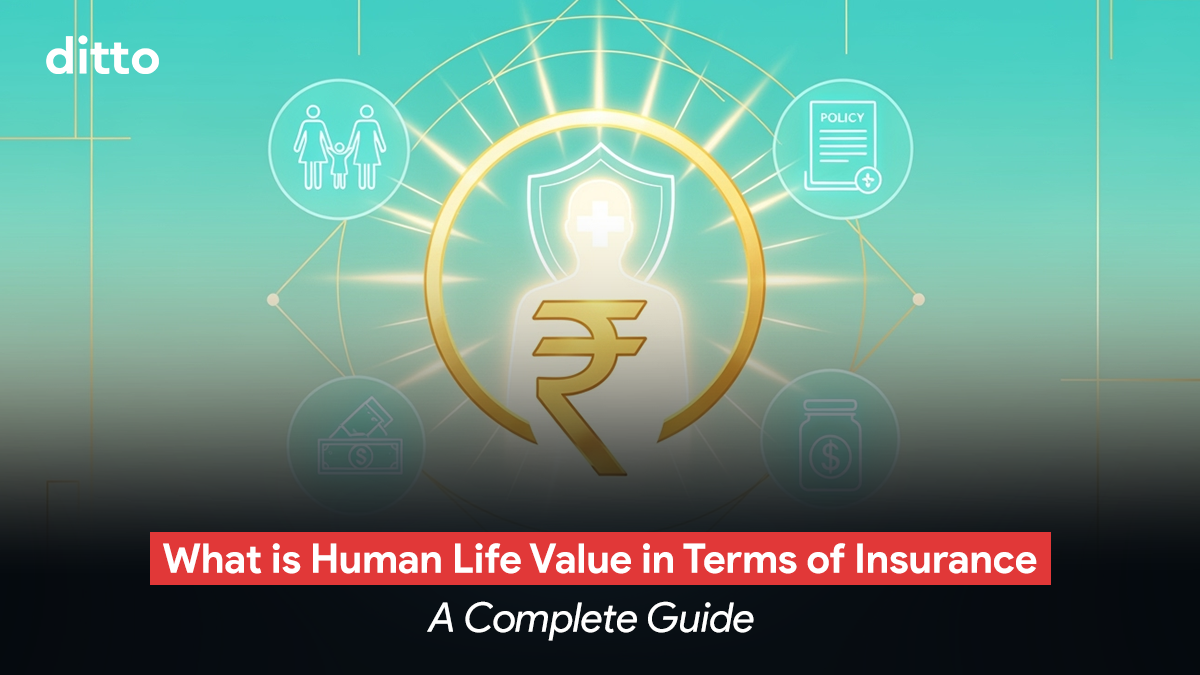| What is Human Life Value in terms of Insurance? Human life value is the monetary value of a person's life. It is determined by the total benefits that others, who depend on the person, are expected to derive from that person’s future efforts. Evaluating human life in this way is important, especially in cases with a sole breadwinner, as it determines how much term insurance suffices to cover both present and future expenses of the dependents. Factors like an individual’s age, gender, planned retirement, occupation, and annual wage often determine HLV. They also reflect the potential financial loss to dependents, are by no means exhaustive. |
Life insurance is often misunderstood, not in terms of whether people should buy it, but how much cover they actually need. Despite growing awareness, insurance penetration in India fell to just 3.7% in FY 2023-24, down from 4.0% the year before. This gap means millions of families remain underinsured.
At Ditto, our advisors handle thousands of conversations every month where customers either underestimate their needs or end up buying oversized covers they don’t really require. The human life value method offers the best way to quantify your financial worth to dependents, ensuring they’re protected without overspending on premiums.
For this guide, we analyzed IRDAI circulars, insurer-provided calculators, and case studies where HLV was the deciding factor in choosing the right cover.
Heads up! We know that life insurance can be overwhelming – but it doesn’t have to be! Our IRDAI-certified advisors at Ditto assess your requirements and can help you pick the right policy. And the best part? We don’t spam or pressure you to buy.
Why Do We Calculate Human Life Value (HLV)?
HLV is calculated to estimate the economic worth of a person's life based on their future income and financial responsibilities. It helps you determine the right amount of life insurance coverage to financially protect your dependents in case of an untimely death.
The primary reasons for calculating HLV are:
- To quantify the future income loss and financial support needed by the family.
- To identify the adequate life insurance coverage to meet long-term financial needs.
- To factor in liabilities, debts, living expenses, and future goals like education or retirement.
- To plan financial security and prevent hardships for loved ones after the breadwinner’s demise.
- To ensure insurance protects against inflation and changing life circumstances.
Note: Insurance coverage must be reviewed every 3-5 years and on important life events such as marriage, childbirth, and taking loans. Regular reviews ensure the coverage aligns with changing financial responsibilities and life circumstances.
| Did You Know? Life insurers generally rely on the income-based method to decide the maximum cover they can offer an individual. The calculation is linked to three primary factors: Age: Younger applicants with more working years ahead are eligible for higher cover, since their future income potential is greater. Education: Higher educational qualifications are often associated with better career progression and rising income levels, which insurers consider when setting limits. For example, a graduate earning ₹5 LPA may qualify for coverage worth ₹1 crore, whereas a 10th-pass individual would need to demonstrate a documented income of at least ₹10 LPA to be eligible for the same coverage. Annual Income: Most insurers cap coverage at around 20–30 times the annual income, ensuring the sum assured reasonably reflects the applicant’s earning capacity. These multipliers usually apply only if a person’s income is above ₹5 LPA. For those earning between ₹3 LPA and ₹5 LPA, insurers may instead offer a standard cover of around ₹50 lakh. |
How to Calculate Human Life Value: Methods and Examples
There are different ways to calculate HLV, but the three most commonly used methods are:
Income-Based Method
This method calculates HLV by estimating the present value of future income the individual is expected to earn, minus personal expenses and taxes.
Pros: Simple and focuses on income replacement; widely used and understood.
Cons: Ignores specific future financial needs, such as education or debts, and may undervalue life’s non-financial aspects.
Suitable for: Individuals seeking a straightforward estimate based on their future earning potential, mainly wage earners without complex financial obligations.
Process:
- Start with your annual family share of income (your income minus personal expenses).
- Project this amount year by year until retirement, increasing it each year by an assumed inflation rate (e.g., 4-5%).
- Sum all the annual inflated amounts to estimate the total coverage needed.
Example:
- Annual income: ₹10,00,000
- Family’s share (after personal expenses): 70%
- Protection period: 25 years
- Inflation rate on family’s share: 4% annually
Calculation (Yearly inflated family income):
- Year 1: ₹7,00,000
- Year 2: ₹7,00,000 × 1.04 = ₹7,28,000
- Year 3: ₹7,28,000 × 1.04 ≈ ₹7,57,120
- Year 4: ₹7,57,120 × 1.04 ≈ ₹7,86,405
(Continue applying 4% inflation each year up to year 25.)
The total inflation-adjusted amount is approximately ₹3.22 crore.
Need-Based Method
This approach analyses the financial needs of the family, such as future expenses like education, loans, and living costs, to determine the required coverage.
Pros: Provides customized coverage based on realistic family needs and goals.
Cons: Requires detailed financial planning and can be complex to calculate accurately.
Suitable for: Those who want to quantify life insurance based on specific future family needs, including education, debts, living expenses, and special goals.
Process:
- Start from household expenses (not your investments/EMIs).
- Decide how many years you want this lifestyle maintained.
- Increase expenses by inflation each year and total them.
- Add any outstanding loans you want cleared.
- Optionally, subtract existing insurance or survivor income if you want a leaner figure.
Example:
- Age: 40 years
- Coverage: Up to 60 years
- Household monthly expenses (excluding EMIs/investments): ₹50,000 (equals ₹6,00,000 annually)
- Inflation rate: 5% annually Outstanding loans: ₹10,00,000.
Calculation: Grow expenses each year by 5% over 20 years, then sum the inflated expenses.
Total of inflation-adjusted expenses over 20 years is approximately ₹1.98 crore. Add the outstanding loan amount of ₹10 lakh. So, the conservative cover target will be ₹2.08 crore.
Note: This method factors in only inflation-adjusted expenses, excluding EMIs and investments. Ditto’s calculator follows this expense-replacement approach, asking users to enter loans separately while also accounting for insurer limits based on age, income, and education.
Income Multiple (Quick Thumb Rule) Method
This quick method multiplies the current annual income by a fixed number (usually 10-20) to estimate HLV.
Pros: Fast and easy to use without complex calculations.
Cons: Oversimplifies and may lead to under- or over-insurance since it ignores expenses, future goals, and liabilities.
Suitable for: Individuals looking for a quick and easy life insurance estimate without detailed calculations.
Human Life Value Formula = Annual Income × Income Multiple (which usually ranges between 10-20, depending on age, job stability, and financial obligations)
Example:
- Annual income: ₹10,00,000.
- Multiple chosen: 10× to 15×.
- Cover range: ₹1.0 crore to ₹1.5 crore.
Note: This quick estimate usually falls short compared to detailed expense or income-based methods, particularly for families with higher expenses or bigger financial goals.
How Does Ditto’s (Need-based) Calculation Differ From Other Methods?
- Inputs the Tool Asks For: Your age, protection duration, monthly expenses (excluding EMIs and investments), future goals like a child’s education or home purchase, and outstanding loans.
- Method Explained on the Page: Project future expenses with inflation and add loans (expense‑replacement method). We generally show an example using 5% inflation when projecting expenses to age 60.
- Reality Check: Our advisors also remind you that insurers set an upper limit to coverage based on age, income, or education. They also deduct any existing life insurance you already have from the recommended cover, ensuring you don’t exceed the insurer’s maximum limit.
- Asset Calculation: A lot of calculators online also suggest subtracting personal wealth or assets from the required insurance cover. At Ditto, we strongly disagree with this approach. Assets are meant for long-term wealth creation, while insurance is meant to cover essential risks and ensure that your wealth-building journey remains uninterrupted.
Let’s analyse two cases to understand how Ditto’s calculator works:
Case 1: 35-year-old individual with an annual income of ₹15 lakhs and monthly expenses of ₹40,000 looking for coverage up to 70 years. The person also has a loan of ₹50 lakh.
Case 2: 25-year-old individual with an annual income of ₹10 lakhs and monthly expenses of ₹50,000 looking for coverage up to 65 years.
Here’s a snippet of the term cover suggestions for both individuals based on their age, income, monthly expenses, and other financial commitments.

Note: While the tool on our website is comprehensive, it is still designed keeping an average person in mind. Once you connect with our advisors, at least 5–10 minutes of a 30-minute conversation is dedicated to this subject, with a full discussion tailored to your specific needs.
A Comparison Between Income Method, Expense Method, and Ditto’s Method
| Feature | Income Method (HLV) | Expense Method | Ditto’s Calculator (Improved Expense Method) |
| Starting point | Annual income (family share) | Current household expenses | Household expenses like rent, groceries,utilities (excl. EMIs and investments) |
| Adjusts for inflation? | Yes | Yes | Yes (also assumes that the corpus is invested in risk-free investment like FDs which more or less negate the impact of inflation |
| Loans | Not always | Added separately | Added separately (explicit input because loans/emis don’t go up with inflation) |
| Future goals (education, marriage etc.) | Not explicit | Can include | Not explicit (must inflate expenses or add a lumpsum amount to cover) |
| Assets/Existing insurance | Can subtract | Can subtract | Need to subtract existing insurance, existing assets are for wealth creation. |
| Best for | Salaried, stable income | Families with clear expense budgets | Quick, practical estimate |
| Main risk | Over/under-estimation if income ≠ lifestyle | Forgetting one-time goals/assets | Ignores personal assets, inflation is kept at a fixed average number |
Quick Note: Several things may be unaccounted for in the HLV calculation process. That is why it is always recommended to speak to our experts and get a better understanding of the calculations. So book a call now.
Dittos’s Take on the Human Life Value Approach
Focus on getting reasonably close to the protection you need, not on building multiple Excel sheets or complex models. Whatever number you calculate, your cover will still be capped by the insurer’s maximum limit. Pick an affordable term cover within that cap, and also invest for the long term, especially in equities, which have historically provided the most reliable inflation‑adjusted returns.
Ditto’s calculator gives a quick, inflation-adjusted expense projection, but the real value lies in the advisor conversation, which fine-tunes the number by factoring in insurer caps, existing cover, and long-term wealth goals.
Pitfalls to Avoid
- Don’t double‑count your loans. If you add loans separately, keep EMIs out of “monthly expenses”.
- Always consider inflation because ignoring it makes the cover look too small over long periods.
- A 10×–15× thumb rule for income can be a handy guideline, but it may not truly capture your family’s real financial needs.
- Don’t overestimate the returns your family can earn on the death benefit, as this may be their last safety net. Always assume only risk-free options like FDs or government securities.
Why Choose Ditto for Your Life Insurance?
At Ditto, we’ve assisted over 7,00,000 customers with choosing the right term insurance policy. Here’s why customers like Arun love us:

✅No-Spam & No Salesmen
✅Rated 4.9/5 on Google Reviews by 15,000+ happy customers
✅Backed by Zerodha
✅Dedicated Claim Support Team
✅100% Free Consultation
You can book a FREE consultation. Slots are running out, so make sure you book a call now!
Final Thoughts on Human Life Value in Terms of Insurance
When it comes to term insurance, a single plan cannot meet everyone’s needs. The right coverage depends on factors like age, income, dependents, lifestyle, and long-term financial goals.
Instead of guessing, always use trusted methods like HLV to get a realistic estimate. This specific method works best if you are the sole or primary earner in the family. It also ensures your family continues to live comfortably, even in your absence.
One drawback would be that HLV assumes your income won’t change in the next few years. Think about job changes, increments, or even starting up your own business. That’s why it is always best to speak with a trusted, IRDAI-certified advisor who can help you personalize your plan.
Confused about your term insurance cover or its beneficiaries? Book a call or WhatsApp us to get advice from our advisors.
Frequently Asked Questions (FAQs)
Can individuals with similar incomes have different HLVs?
Yes, HLV can vary even among individuals with similar incomes, as it depends on personal liabilities, dependents, lifestyle, and future expenses. These unique factors result in different HLVs and reflect each person’s specific financial responsibilities and insurance needs.
Is Human life value only used for term insurance policies?
While commonly used in term insurance, HLV can also apply to all types of insurance plans to assess adequate coverage for dependents.
Can I calculate Human Life Value using online tools?
Yes, many insurers and financial websites offer HLV calculators that provide quick and accurate estimates based on your income, expenses, and age, making it easier to plan your desired life cover.
Do homemakers or caregivers without income need life insurance?
Yes. Even without a salary, their household contributions have real replacement costs (childcare, elder care, daily management). If something happens, families may face significant expenses to replace these roles. Many insurers now offer term plans for homemakers, often based on the spouse’s income or existing cover.
Last updated on:










